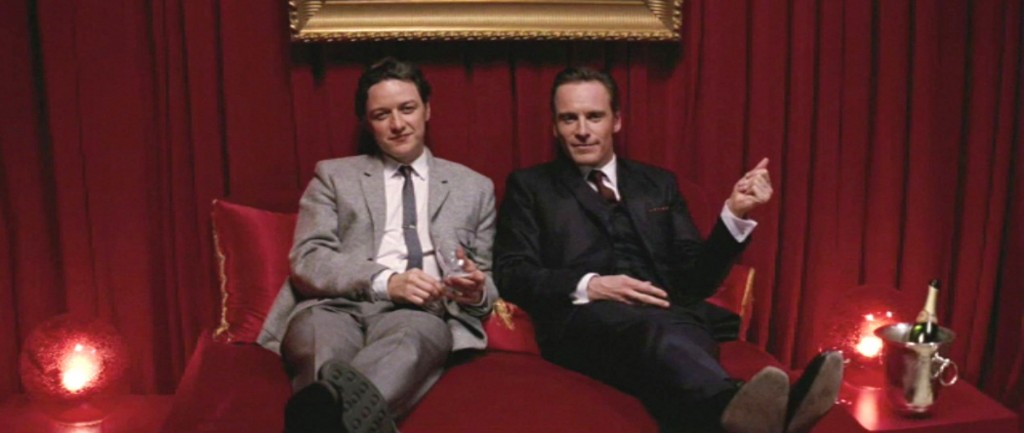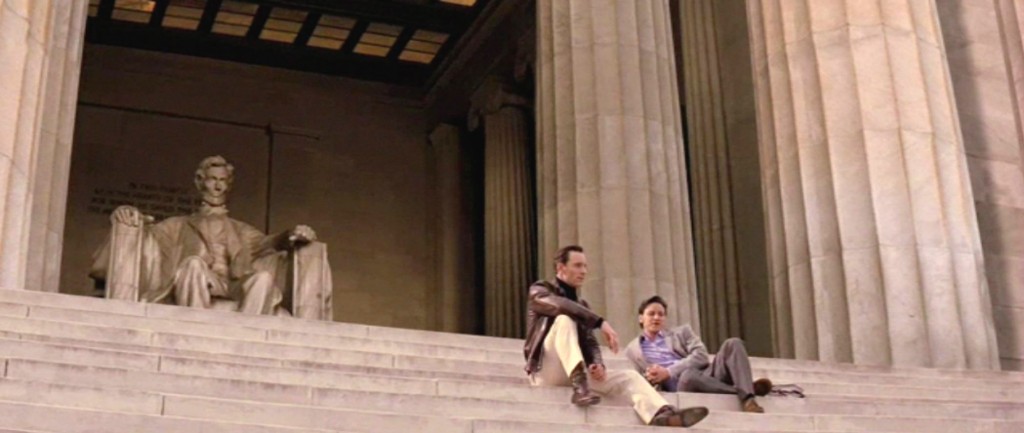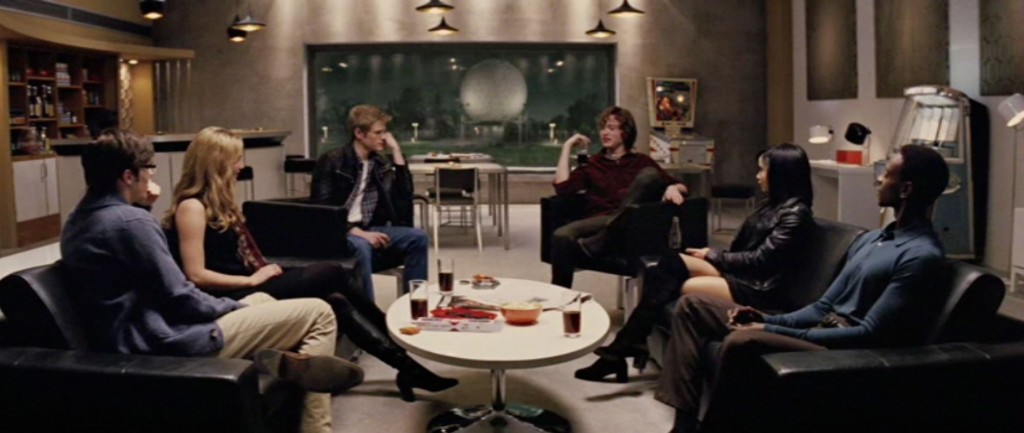X-Men: First Class part 7
Erik and Xavier, two straight men in 1962, have fallen in love. Like all straight men who fall in love, they must find things to do together in order to have an excuse to hang out. The manlier the better. Hence, the first thing they do after deciding to work together to find Shaw is to go to a strip club and indulge in some very groovy Mad Men style sexist shenanigans. The joke here being, of course, that they’re not looking for sex but for mutants, in this case a winged young lady named Angel Salvador. Still, the message is clear: like James Bond, Erik and Xavier have found that saving the world doesn’t have to mean you can swing a little. Next, they find a young black cabbie in NYC named Armando Munoz, a imprisoned young man named Alex Summers, an awkward youth with a hyper-sonic voice named Sean Cassidy (not Shaun Cassidy), and, briefly, a taciturn guy named Logan, who, in the movie’s single funniest moment, politely rebuffs their advances. Even Erik and Xavier strike out sometimes, and not everyone wants to join a family.
The team that they assemble are all variations on the Other — a stripper, a black youth, a prisoner, an awkward, rejected teen boy, they’re like the cast of a Bob Dylan song come to life. We’re watching the 1960s come together. Logan, of course, had his ’60s a hundred years earlier, this is not his movement. (I also note that Armando, while black, is not black and angry, just a working-class dude driving a cab, which makes him “other” enough in 1962 New York, no reason to disenfranchise him as well, or make him a stereotype.)
Meanwhile, in the Arctic, Shaw and Emma and Azazel luxuriate in Shaw’s swanky submarine. Shaw tans himself in the sub’s nuclear reactor while Emma and Azazel try to figure out where Xavier is — they know someone is onto them. Nuclear submarines were brand new at that time: the Thresher had just been launched a year prior to the events of First Class, and would tragically sink a year later. The exposition in the submarine scenes is perfunctory, but what counts is the attitude: Shaw, Emma, Azazel and Riptide are crewing a submarine while dressed for yachting. Bond villains always dress well but have crowds of soldiers working for them; Shaw keeps his crew small, efficient and stylish.
In case the viewer felt that the movie didn’t have enough references to early 1960s politics, Erik and Xavier go to Washington DC to lounge on the steps of the Lincoln Memorial, where Dr. Martin Luther King would, a year hence, launch the Civil Rights Movement, yet another plot to normalize the Other in the US. Xavier, ever the idealistic 1960s liberal, expounds to Erik about how he “feels” the mutants out there, feels their pain and isolation, wants to help them, knows he can help them. He looks like he’s ready to form the Peace Corps. This kind of idea would have had no traction under Eisenhower, it took Kennedy and Camelot for Americans to see themselves as pacific leaders taking the world into the 21st century. Erik, who has seen Otherness from the other end of the telescope, knows the flip side of Xavier’s dreaming: raising up the Other may seem like a good idea, but that idea exists for the purpose of making the liberal feel good about himself, not for the benefit of the Other. The downside of raising someone up is that they are made a target, in Dr. King’s case, quite literally, and postwar US history is filled with disasters undertaken out of kindness.
It’s this kind of density, this kind of examination of theme, not just in metaphors but in concrete historical reality, that makes First Class the best of the X-Men movies by far. The earlier movies discussed Otherness in wide-ranging, crazy-quilt ways and were set in a vaguely-defined future. You could find yourself in the X-Men universe but you couldn’t feel the grit of it. Here, the characters exist in an all-too-real, identifiable context.
Back at the ranch, or rather the MiB HQ, Raven bonds with the other X-Men kids by announcing her new identity: Mystique. Ever the front-runner, her choice of name predate’s Betty Friedan’s book The Feminine Mystique by a year. The Feminine Mystique, it’s worth noting, was the first book that identified a widespread problem in the US: women — white, middle-class women anyway, the Betty Draper’s of the world — were becoming bored and unhappy with their parochial, dead-end lives. The actual phrase, “the feminine mystique,” was a term Friedan coined to describe the “ideal woman” that had been created by the Don Drapers of Madison Avenue: beautiful, stylish, poised, subservient and utterly vacant. Real women, Friedan insisted, want something more than a husband and kids and postwar affluence. Raven, who lives her entire life in the disguise of a beautiful, poised, subservient woman, feels this tension acutely — it’s no mistake that she becomes Mystique.
Armando, for his part, becomes “Darwin,” for his ability to adapt and survive. Aha — that’s why he’s shown driving a cab rather than storming the gates of the white establishment: he’s not a rabble-rouser, he’s an adaptor. He will do whatever works to ensure his survival. (The truly freaky Darwin, who can grow gills at a moment’s notice and who knows what else, is a character largely new to this movie, I’m guessing he was included so that there would be a black character — any black character — placed in the context of the early 1960s. Sean becomes Banshee, after a character in Irish folklore: oddly, a female character, who’s wail signals an imminent death, an odd mixture of feminine and tough for a young Irishman. The mixed-race Angel (an Other twofer), appropriately, has two talents: in addition to her dragonfly wings, can also spit fireballs. Alex, the troubled youth of the bunch, can sling laser-hoops out of his body, and becomes Havoc. The tone of the scene, set to the slinky groove of “Green Onions,” is youthful energy. These kids aren’t angry, they’re overjoyed to have found each other, and we’re reminded that the youth movement of the 1960s sprang not from a hippie conspiracy but a statistical fact: the Baby Boomers didn’t ask to all be born at once, it just happened that way, but as the 1950s gave way to the 1960s, “youth” became a “problem” for politicians to solve. Youth, in fact, became its own Other, and the scene at MiB HQ, with the symbolic destruction of the statue of the MiB himself, shows a rebellion movement born of joy and self-realization.



Again, connections I didn’t consciously make: I knew it was the Lincoln Memorial, and I knew this was generally the time of the Civil Rights Movement, but I didn’t get as far as the specifics of King giving his speech from that location a year later.
The truly freaky Darwin, who can grow gills at a moment’s notice and who knows what else, is a character largely new to this movie, I’m guessing he was included so that there would be a black character — any black character — placed in the context of the early 1960s.
Yeah . . . I wish they’d done better by him, though. It’s a problem when your non-white heroes all end up either dead or heel-turned, and the fact that there are also white people on Shaw’s/Magneto’s side doesn’t fix it. I know that Magneto’s acknowleding their alienation rather than trying to sweep it under the rug the way Xavier does — which goes a long way toward explaining why Angel and Mystique join him — but it would have felt more balanced to me had the script not also killed Darwin, the Token Black.
Since they consciously made Darwin a non-stereotype, it’s especially disappointing that they then make him a different kind of stereotype: the sacrificial Negro.
And they can’t even make the “there weren’t Black characters in the original comic team” argument either, since their team is not based on the original X-Men lineup. If it were meant to analogous, Angel would be an ideal stand-in for the original Angel.
Have we passed the scene with Xavier getting aerie to move the satellite dish yet?
At this point, I’m pretty unpersuaded in the first place by any “there weren’t any non-white people in the original” argument that’s based on fiction, rather than history. It’s all made up anyway; just make up something different. Thor had a black Heimdall. I am a rampaging Norse mythology purist, but I didn’t mind. Because Marvel Asgard =/= real mythology, so why shouldn’t alien!Heimdall be black?
And even in history — eh. I don’t need to see specific historical figures racebent (the solution there is to pay more attention to actual people of color in history), but I frankly don’t mind the Doctor Who approach of having black noblewomen in eighteenth-century France or whatever. If you’re already playing fast and loose with historical reality, you might as well extend that flexibility to an issue that’s often been changed in the other direction.
When Darwin came aboard, I stopped and thought about who else in the movie could have been black, and still have the narrative have its historical resonance. Erik couldn’t, because he’s a Jew, Xavier couldn’t, because he’s a super-wealthy child of privilege, Raven couldn’t because she’s posing as Xavier’s sister, etc. Going down the list, I don’t have an answer for this, I just wish Darwin could have been better used.
Rewrite his death scene so that it’s somebody else who kicks the bucket, and leave Darwin in the party.
I was looking up information on the X-MEN FIRST CLASS sequel, DAYS OF FUTURE PAST, and saw this quote that you will appreciate:
‘On how First Class 2 could open, Vaughn said: “I thought it would be fun to open with the Kennedy assassination, and we reveal that the magic bullet was controlled by Magneto.”’
It’s completely consistent with XMFC’s approach to mutant-influenced history, but probably way too dark and uncomfortable to actually appear in pop action movie.
You’ve probably heard that DAYS OF FUTURE PAST has a time travel hook and will have Patrick Stewart and Ian McKellan (probably) reprising their roles as Xavier and Magneto. It’s based on a popular X-Men storyline from 1981 in which the present-day X-Men have to avert a disaster that leads to a dystopian future with mutants hunted down and placed in concentration camps. Given the ages of Stewart and McKellan, this “future” will probably take place in some far-flung year like 2014, when the film is scheduled to be released. So to the XMFC characters in the 1960s, their future is our chronological present, which makes my head spin.
As I recall, the year that the dystopian future of the original Days of Future Past is set in is either now or very close to now, so it would be comic book accurate as well as movie timeline appropriate to set the “future” story in the present day.
I dunno — the studios may feel that the Kennedy assassination is ancient enough history for most of their intended audience that it’s fair game for that kind of treatment. For people who remember Kennedy, it will probably be dark and uncomfortable, but I’m not sure that will be true for everybody.
And I hadn’t heard that about Days of Future Past; interesting. It continues with the theme of this series being far more concerned with thinking through its worldbuilding, and telling a story deeply embedded in time and political reality.
For what it’s worth, The Comedian already killed Kennedy in Watchmen.